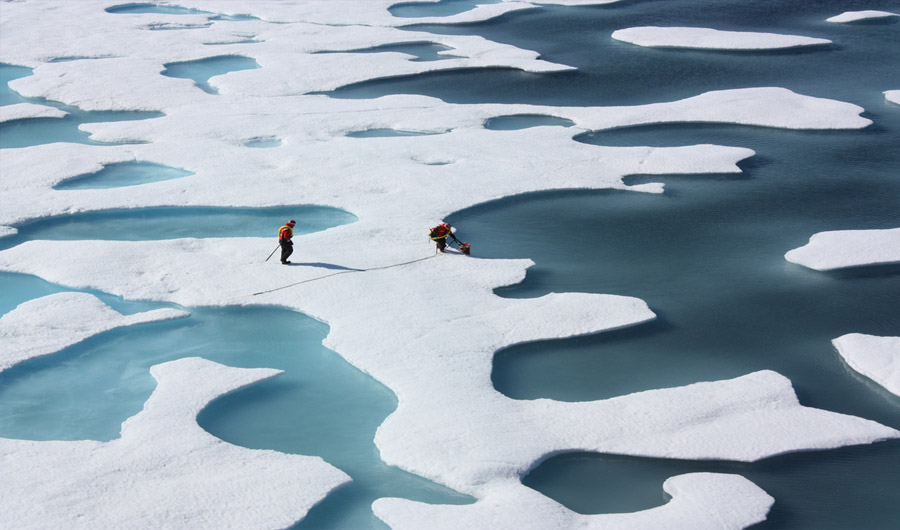Humans May Have Altered Arctic Ice Much Earlier than Thought

(Inside Science) -- For 40 years, heat trapped by human-caused greenhouse gas pollution has been eating away at Arctic sea ice. But for a brief span in the 20th century, Arctic sea ice was actually increasing -- and that may be our fault too, according to a new study.
The researchers used historical measurements to learn how the ice had changed, then modeled climate variables to untangle the causes. They found that between 1950 and 1975, certain types of air pollution counteracted the effects of greenhouse gases that hold heat in the Earth's atmosphere. The balance of these gases at that time cooled the Earth and helped sea ice to grow. The findings emphasize the fragility of the Arctic sea ice system, with humanity's changing pollution habits buffeting the region first one way, then the other.
"I think what it's telling us is that humans had an impact on the Arctic much earlier than had been thought," said John Fyfe, a senior scientist at Environment and Climate Change Canada in Victoria, British Columbia and one of the authors of the study, which appeared today in Geophysical Research Letters.
When people burn fossil fuels, they produce a range of different pollutants that can "force" the climate to react in different ways. Greenhouse gases -- like carbon dioxide -- trap heat and warm the planet, while fine particles suspended in droplets, known collectively as aerosols, usually cool the planet by reflecting the sun's energy away.
"It's a tug-o-war between these two forcings as to what the climate is actually going to do," said Fyfe.
In the mid-20th century, coal-burning power plants and other sources released huge amounts of sulfur dioxide, which then formed toxic sulfate aerosols in the atmosphere. Past research has suggested that the cooling influence of these sulfate aerosols helped counteract warming from greenhouse gases, said Fyfe. But around 1970, the U.S. Clean Air Act and other air quality regulations started curbing sulfate aerosol production. Sulfate aerosols degrade relatively quickly, so people soon enjoyed air that was healthier to breathe. Meanwhile, production of greenhouse gases -- which linger in the atmosphere much longer than sulfate aerosols -- has continued, causing average global temperatures to rise.
The new study examined what this meant for Arctic sea ice. Unlike land ice, floating sea ice doesn't affect sea levels when it melts and freezes. But it does play an important role in the global climate and ocean currents, acting somewhat like the radiator and water pump in a car, said Andrew Mahoney, a sea ice geophysicist at the University of Alaska in Fairbanks who was not involved in the study. Sea ice is also crucial to Arctic ecosystems, supporting nutritious algae that other organisms feed on, he said. The ice releases algae as it melts, so changes to the yearly freezing and thawing cycles could throw the food web out of whack.
"The growth and melt of sea ice is like a pulse in the Arctic that's timed to all of the other species that live there," said Mahoney.
Researchers have documented rapid declines in Arctic sea ice since the late 1970s, when the satellite record begins. Earlier data are scarce, but past research has suggested that Arctic sea ice increased between about 1950 and 1975. Fyfe and his colleagues confirmed these findings using data from several historical sources, including maps that once helped Russian ships navigate icy northern waters. The data show that Arctic ice went through an expansion as dramatic as its subsequent decline, said Fyfe.
Next, the researchers used a mathematical model of Earth's climate to simulate different scenarios, playing out what would have happened without particular pollutants or natural phenomena. The simulations indicated that about a third of the sea ice increase was due to natural processes, while two-thirds was due to aerosol pollution from human, or anthropogenic, sources.
"Arctic sea ice was increasing -- that's clear and unequivocal now during this time period," said Fyfe. "And through these model experiments, we've been able to determine that the increase was due to anthropogenic aerosols."
Not everyone is convinced about the role of aerosols, however. Vladimir Semenov, a climate scientist at the Institute of Atmospheric Physics and the Institute of Geography in Moscow, who was not involved in the study, attributes the period of ice growth mostly to natural variability, although he said aerosols probably also play some role.
"It's an interesting result in the sense that the model showed that such a response [of aerosols on sea ice] is possible," said Semenov. "But to make sure whether it's just an outlier, or really some reliable physical result, you have to check other models."
Mahoney agrees that the new study needs to be replicated with other climate models. But, he said, the results are plausible, and they demonstrate the profound effects of our species' actions.
"I think it suggests that the climate may be more sensitive than we realize to human activities," he said. "When we try to do an environmental accounting of the impacts of our activities, we need to be very broad in our thinking about what to include."

